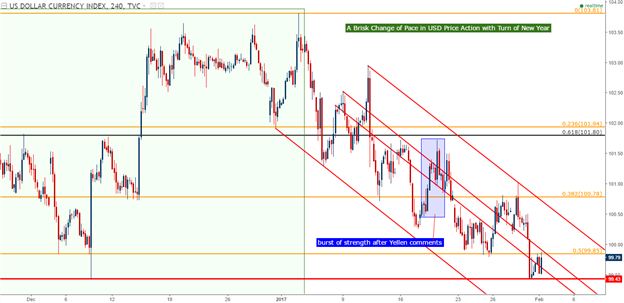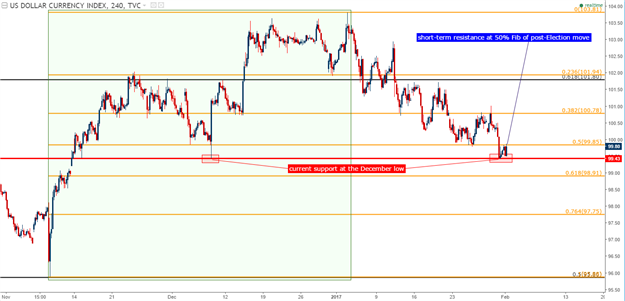USD Pinned to Support Ahead of FOMC
Over the past few weeks, we’ve been discussing the retracement in the U.S. Dollar that lasted for most of January, and at this point we’ve seen more than 50% of the post-Election move in the Greenback wiped away. And while this does raise questions on the sustainability of that bullish move that started with an aggressive reversal on the night of the U.S. Presidential election, traders will likely want to evaluate price action in response to the remainder of this week’s data before making any long-term deterministic decisions on the Greenback.
Today at 2 PM we get the Fed, and at 2:30 PM ET the start of Chair Yellen’s press conference; and on Friday we get Non-Farm Payrolls for the month of January, so this week can bring a big change-of-pace to USD, one way or another.
The Dollar’s price action has been rather weak throughout January as the Fed has been rather silent throughout the month. Janet Yellen had one relevant public appearance in January in which she echoed what she had previously said in December regarding the expectation for ‘a few hikes this year’. And this brought a quick burst of strength into the Dollar, albeit short-lived as sellers took back over.

Chart prepared by James Stanley
This run of weakness in USD leaves the Dollar’s intermediate-term price action in a rather precarious state. On the chart below, we’re zoning-in on the post-Election move in USD, and notice how the December swing-low is showing current price action support, with the 50% Fibonacci retracement of the post-Election move serving as near-term resistance.

Chart prepared by James Stanley
For USD Weakness Strategies
Of recent, both the Euro and Cable have begun to show semblances of bullish price action, and to be sure at least a portion of this is likely related to that recent inclusion of USD weakness. But given geo-political pressure points, there may be some motivation for trends in each of these markets to continue developing; as both economies were previously being sponsored by outsized QE programs that are unlikely to be increased or extended. In March, the ECB’s first QE program expires and that will leave the bank with €60 Billion a month in QE outlays for the rest of the year, which would effectively be a taper from the bank’s prior €80 Billion/month program.













Leave A Comment